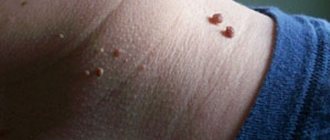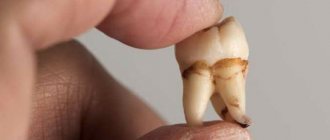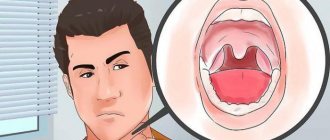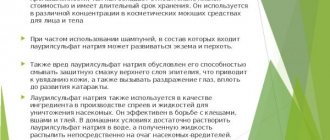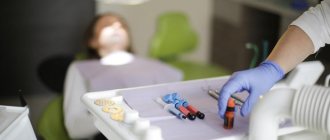Pain under the jaw: what causes unpleasant symptoms and how to eliminate them
If you have pain under your jaw, you should not ignore the unpleasant symptoms. They can talk about a number of diseases, some of which pose a serious danger to the body. Pain can also be caused by mechanical stress. When a blow occurs, you should ensure the integrity of the jaw. In any case, you need to visit a doctor. You may need to consult a dentist, surgeon, neurologist, otolaryngologist, or others. To understand which doctor is needed, it is worth analyzing the nature and location of the pain.
What could be the cause of the discomfort?
Pain under the jaw can occur on the left and right, with pressure or at rest. It can be provoked by many reasons - dental diseases, bruises, damage to nerve endings, etc. Among the most common causative factors are:
- Bruxism (teeth grinding). In some people, the anomaly manifests itself during nervous tension. But more often this disorder occurs in a dream, so a person does not even suspect that he is suffering from bruxism. In addition to wearing away tooth enamel, it can cause jaw pain.
- Dental diseases: deep caries, pulpitis, periodontitis, sialolithiasis (salivary stone pathology). More often, painful sensations appear when an infection affects the pulp. Microorganisms spread along the root canal and infect nearby tissues. This explains why my jaw hurts.
- Osteomyelitis. When the disease occurs, the infection spreads throughout the body through the bloodstream, affecting bone and soft tissue. If osteomyelitis of the jaw develops, the temporomandibular joint (TMJ) is often involved in the painful process. In this case, in addition to painful sensations, the temperature rises and the face swells.
- Neurological and vascular pathologies - for example, neuralgia, dysfunction of the heart vessels. With arteritis, when the facial artery is affected, pain begins in both jaws. The end point of the painful arc is the corner of the eye. With neuralgia of the glossopharyngeal nerve, there is severe pain under the chin when pressed or at rest. The main reason for the development of pathology is hypothermia and viral infections.
- Fracture. Possible with strong impact on the jaw. In this case, acute pain is felt, the face swells, and hemorrhage is observed. With a fracture, chewing is difficult or even impossible.
A child’s chin may hurt during the period of changing teeth. This is explained by the fact that as they grow, the nerve is pinched, which provokes unpleasant sensations. Attacks can last from a few minutes to an hour. To rule out various diseases, the child should be shown to other specialists. Difficulty cutting through the figure eight in adults can also cause a sore throat that radiates to the jaw. Pain is considered normal even after tooth extraction, especially the third molar, if it does not increase and unpleasant symptoms do not persist for more than 7 days. Otherwise, you need to consult a doctor.
Wearing orthodontic appliances also causes some discomfort. So, when using a braces system, the arch, acting on the teeth, promotes their movement. The roots put pressure on the bone tissue, which provokes a dull aching pain in the jaws at first. It happens that painful sensations are caused by excessive tension of the arch. For the unpleasant symptoms to disappear, you only need to weaken it.
Is it possible to correct gravitational ptosis with massage?
Facial massage is one of the main ways to maintain facial muscles in tone, which also helps improve skin condition, facial tone, and make the oval of the face and cheekbones clearer. During the procedure, muscles that are tense during the day and even during sleep relax. For example, one chewing muscle presses on the molars with a force of up to 90 kg. If this tension is not relieved, then habits such as involuntary clenching of the teeth, grinding them down, tics, headaches, and changes in the shape of the face may appear. When muscles are tense for a long time, that is, they are contracted, blood and lymph circulation in them decreases, metabolic products accumulate, inflammation and fat deposits may appear, this will lead to increased signs of facial aging. Facial massage is the only and natural way to get rid of such tension and its manifestations.
In addition, it has a lymphatic drainage effect, enhances the tone of the lymphatic vessels, lymph circulation in them, as a result of which the content of toxins and metabolic products in the tissues is significantly reduced, excess intercellular fluid (edema) is removed, that is, lymphatic drainage in the tissues is improved. Facial tone noticeably improves with a course of lymphatic drainage massage at any age. In order for the results of the massage to last for a long time, it is recommended to undergo a course of 10-14 procedures, once a week, and then a maintenance procedure once every 2 weeks.
Lymphatic changes as one of the causes of pain under the jaw
When discomfort occurs, it is first necessary to assess the health of the submandibular lymph nodes. It is worth excluding or confirming (if pathology is present) lymphadenitis - inflammation that develops when an infection enters the lymph nodes. The disease in its acute form is accompanied by severe pain, body temperature rises, and weakness appears. Discomfort is especially acute when pressing on a sore spot. If timely treatment is not carried out, the disease enters the chronic stage. With different forms of lymphadenitis, an abscess or phlegmon can develop - a purulent formation.
Lymph nodes can become inflamed, for example, in acute and chronic tonsillitis. In this case, it can hurt from different sides under the jaw. But other symptoms come to the fore: acute pain in the throat (especially when swallowing), purulent plaque on the tonsils, fever - even up to 40˚C.
If the lymph node in the neck hurts, this may also indicate the appearance of a neoplasm. More often these are metastases that penetrate from other organs. The nature of the pain varies. The patient has an elevated body temperature for a long time, weakness appears, and he sharply loses weight.
The nature of pain depending on the type of disease
Since various diseases can provoke discomfort, its nature will differ:
- Arthrosis. There is a constant aching pain. It is also accompanied by a crunch. If you open your mouth too much (or while chewing), the pain increases. In most cases, attacks occur in the morning.
- Migraine. With this neurological disease, pain is usually felt in the neck under the jaw on one side. It intensifies when exposed to irritants - bright light, sudden changes in lighting, loud sounds, strong odors. Other characteristic symptoms include thirst, nausea, spots in the eyes, and speech disorders. The duration of attacks is from 3 hours to 4 days.
- Angina. The disease is accompanied by pain under the jaw and in the throat. It intensifies when swallowing. Often the patient even refuses food. Painful sensations can also be felt in the ear.
- TMJ dysfunction. With pathology, pain appears in the lower jaw, in front of the ear, in the forehead and cheeks. Characteristic “clicking” sounds may occur. Sometimes there may even be a “jamming” of the jaw. The pain is characterized as prolonged, dull, muffled, becoming more acute when opening the mouth wide or chewing.
- Neuralgia of the ear node. The pain manifests itself in attacks that can last up to an hour. It radiates to the lower jaw and temple. Strengthens when pressed. The person may feel a "clicking" sensation in the ear.
- Benign tumors. In the initial stages of the disease, the patient does not notice any symptoms. Sharp pain with osteoid osteoma is felt already in advanced disease. Osteoblastoclastoma is accompanied by aching pain in the jaw. The temperature may also rise, and a pale pink growth appears on the gums. Late forms of adamantioma are characterized by sharp pain in the jaw, the intensity of which increases with chewing.
- Malignant tumors. At first, the pain is practically not felt, but after a while it will be impossible to live normally without analgesics. So, with osteogenic sarcoma, which develops in bone tissue, the pain is very strong. The attacks are prolonged.
Sharp and severe pain in the chin in some cases is the first sign of myocardial infarction and angina. The localization of unpleasant symptoms in this case is often on the left.
Prevention
A variety of preventive measures will help prevent the disease from exacerbating and returning. First of all, it is maintaining a healthy lifestyle. Engage in moderate physical activity and avoid eating unhealthy foods in excess. If you periodically have pain in your neck under your chin, then do not forget to visit a doctor and consult with him before you feel another pain syndrome. Stop smoking or reduce the number of cigarettes you smoke per day. Try not to abuse alcohol or take medications not directly prescribed by your doctor.
Diagnosis of diseases
Even if the pain is mild at first, over time it can develop into exhaustion. Therefore, do not hesitate to visit a doctor. He will conduct an examination, collect anamnesis, prescribe x-rays and tests. For heart problems, an ECG is additionally performed. If a tumor is suspected, the examination will be more serious, since it is necessary to determine what kind of tumor (benign or malignant), the stage of the lesion, and the presence of metastases.
Taking painkillers can “blur” the clinical picture, so you should not use them without a doctor’s prescription, especially before diagnosis. Only with a correct diagnosis will the doctor be able to determine what to do to eliminate the pathology.
Basic methods of treating pathologies
Analgesics will only hide the symptoms for a while, but will not solve the problem. Therefore, it is necessary to treat the disease that causes pain. Let's give some examples.
Jaw injuries
If you are bruised, you should immediately apply a cold compress and bandage to the sore spot. You should definitely see a doctor to rule out other serious pathologies, such as a dislocation or fracture. During treatment, it is important to ensure complete rest for the jaw.
If the cause of pain is a dislocation, the jaw is set into the correct position and fixed with a bandage, which helps ensure its immobility. In case of a fracture, the traumatologist performs splinting or intermaxillary fixation. If it is open, the technique of osteosynthesis with titanium plates is used.
Treatment of osteomyelitis
The tooth involved in the painful process will have to be removed. When performing manipulations, the doctor in most cases opens a purulent focus in the bone and adjacent tissues. Incisions can be made either intraorally or extraorally. All actions are carried out under local anesthesia. After surgery, it is important to carefully clean the wounds. The doctor prescribes antibiotics, vitamins, painkillers and other necessary medications.
With bone necrosis, the doctor determines how to treat osteomyelitis based on the stage of the inflammatory process.
Treatment of TMJ dysfunction
Pathology therapy involves an integrated approach:
- the use of orthodontic techniques that involve correcting the bite;
- operation;
- “remaking” teeth or prosthetics;
- physiotherapy and acupuncture.
Treatment of sore throat
The doctor determines the treatment method depending on the degree of the disease. More often, the patient is treated at home under the supervision of a specialist. The doctor prescribes antipyretic and antiviral drugs, as well as remedies for sore throat.
Using any folk remedies without traditional treatment is a big health risk. They can only be used in some cases as an auxiliary therapy, after consulting with your doctor.
Each case is individual, and the treatment method for one patient may not help another. Therefore, in any case, it is worth contacting a specialist - a dentist or therapist, for example, and if necessary, he will refer you to another doctor.
Treatment and consequences of a fracture of the zygomatic bone and arch
One of the most common phenomena is a fracture of the zygomatic bone, which can occur anywhere: at home, at work, or during sports. This injury ranks 2nd in the ranking in terms of the frequency of injuries occurring, second only to nasal fractures.
Cheek bone structure
The zygomatic bone is a paired bone that contains thick plates of a sponge-like substance. There are 3 surfaces in it:
- Buccal or lateral, having a convex, quadrangular outline. The antero-inferior edge is located close to the zygomatic process of the upper jaw. The upper part is the frontal process, which has a connection with the zygomatic process of the frontal bone. The posterior edge is located next to the greater wing of the sphenoid bone. The inferolateral angle is formed due to the process of the temple adjacent to the zygomatic process of the temple bone, forming together with it the zygomatic arch. The zygomaticofacial nerve passes through the zygomaticofacial opening, located on the buccal surface.
- Orbital, involved in the formation of the floor and lateral wall of the orbit. On it is located the zygomaticoorbital foramen, through which the zygomatic nerve passes.
- Temporal, directed towards the infratemporal fossa. It has the zygomaticotemporal nerve emerging from the zygomaticotemporal foramen.
Classification
Fractures of the zygomatic arch and bone are classified according to various criteria. However, experts adhere to the following classification:
- Fractures of the zygomatic bone. There are without displacement, with displacement and with violation of the walls of the sinus of the upper jaw.
- Fractures of the zygomatic arch. They are distinguished with and without displacement.
- Fractures of the zygomatic bone and zygomatic arch occurring at the same time. There are displacements, non-displacements and injuries to the maxillary sinus.
Based on the elapsed time since the onset of injury, fractures are divided into the following types:
- Fresh. Happened less than 10 days ago.
- Obsolete. When 10 to 30 days have passed.
- Incorrectly fused and unfused. Occurred over 30 days.
In addition, the following types of arch and bone fractures are distinguished:
- Open.
- Closed.
- Linear.
- Splintered.
Signs
A fracture of the zygomatic arch is characterized by the following symptoms:
- When you try to open your mouth, unbearable pain occurs.
- Mobility of the jaw is impaired.
- If the infraorbital nerve is damaged, the sensitivity of the skin under the lower eyelid, on the cheekbone or nasal wing decreases or completely disappears.
- There is a change in the facial bone due to the displacement of fragments and tissue disruption.
- There is blood coming from the nose.
- Seeing double.
- When palpated, you can feel a bony prominence.
- Swelling around the eyes.
- Purcher's syndrome. There is a possibility of appearance 2 days after the damage. It is characterized by a rapid decline in vision, altered processes in the retina, detachment, or necrosis of the optic nerve.
Diagnosis
A doctor can determine a cheekbone fracture by external examination of the victim and palpation. An x-ray is taken to confirm the diagnosis. It clearly shows the damaged integrity of the cheekbone bone, the presence of a continuous lower and outer edge of the orbit and a decrease in the transparency of the maxillary sinus.
Treatment
There are two methods of treatment: conservative and surgical. They are used based on the type of injury received, the amount of time that has passed since the onset of injury and the individual characteristics of the body.
If the fracture occurs without displacement, the injury is considered quite mild and can be treated conservatively. The surgical method is resorted to in such situations if displacement is observed due to injury. It is represented by a wide variety of techniques.
Surgical treatment
In case of a displaced fracture of the zygomatic bone, in which there are fragments, or an old injury, there is a need for surgical treatment, which includes a wide variety of techniques.


